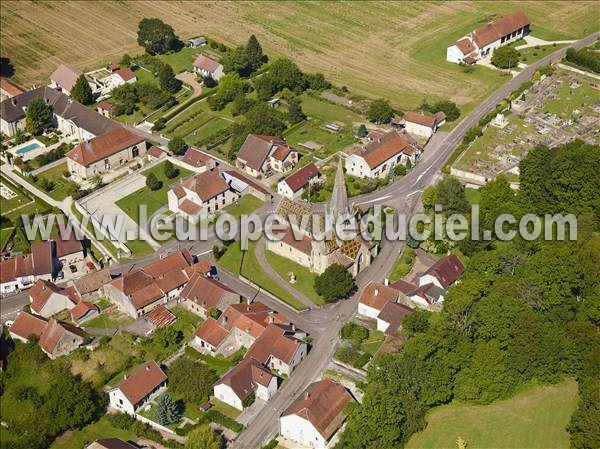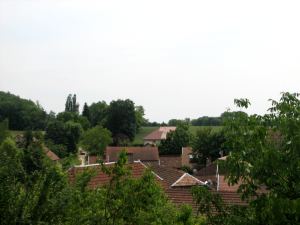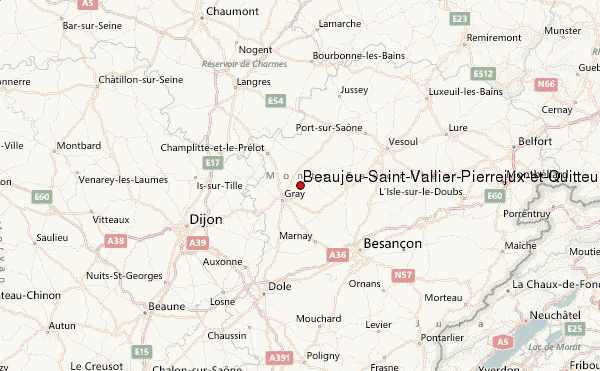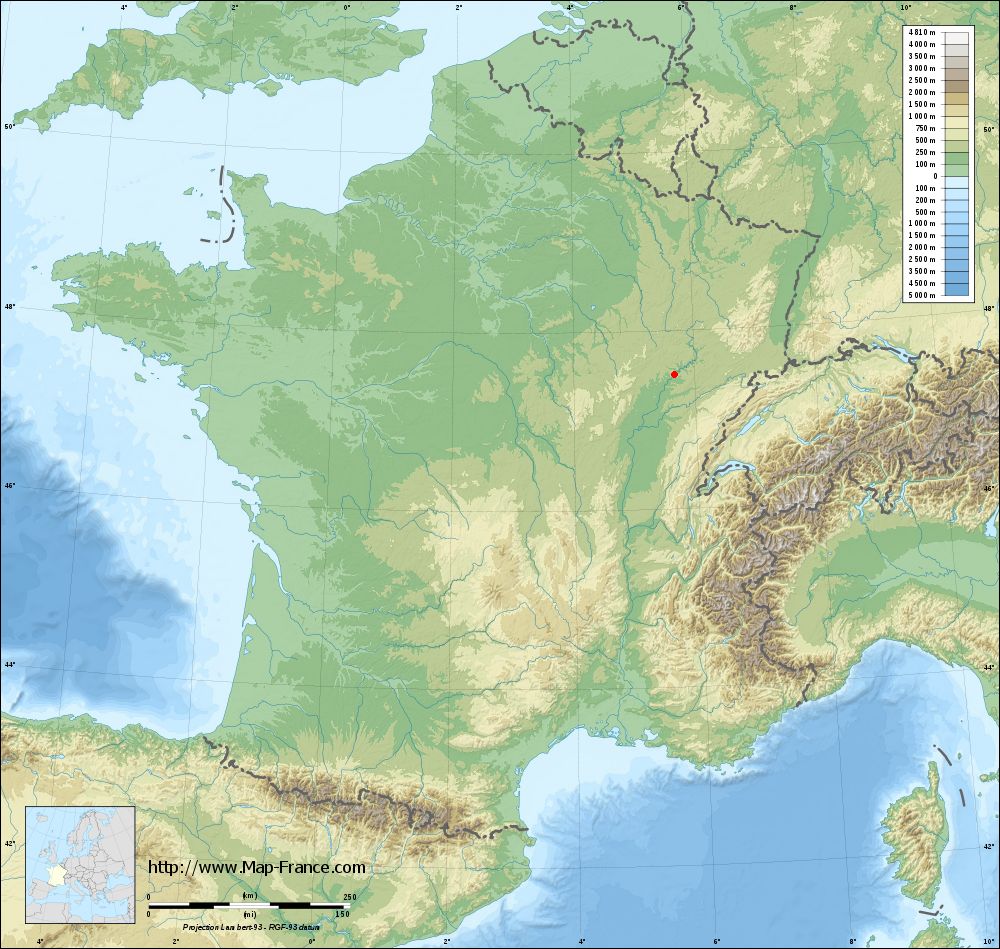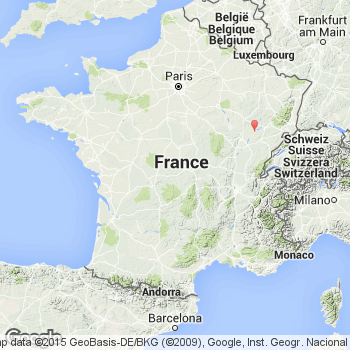Beaujeu-Saint-Vallier-Pierrejux-et-Quitteur
Beaujeu -Saint -Vallier- Pierrejux -et -Quitteur is a commune in Haute -Saône in the Franche -Comté.
Geography
Beaujeu -Saint -Vallier- Pierrejux -et -Quitteur situated at an altitude of 201 m above sea level, 10 km north-east of Gray and about 40 km northwest of the city of Besançon (air line). The village is located in the west of the département, in the plane of Gray on the eastern edge of the Talniederung the Saône.
The area of 35.12 km ² municipal area includes a portion of the middle Saône Valley. The western and northern border is always along the Saône, with large loops here flows through a wide Alluvialniederung. The flood plain is on average 195 m and has a width of about two kilometers wide. The river is channeled and expanded to waterway. In the partially swampy Talniederung predominant agricultural use.
From the river, the municipality's area extends eastward across the Talniederung and a gently rising slope up to the adjacent plateau. It is subdivided by several short tributaries of the Saône, including the Pothelet and Raye. The plateau consists of an alternation of calcareous and sandy- marly sediments of the upper Jurassic period and especially in the Southeast and from Tertiary deposits. It is 230 m. While in the northern part outweighs arable and meadow land, the entire eastern part (40 % of the municipal area ) covered with forest ( Forêt Domaniale de Belle Vaivre ). On a hilltop in this forest area is 252 m reaches the highest point of Beaujeu -Saint -Vallier- Pierrejux -et -Quitteur.
The community consists of four districts, all located on the eastern edge of the Saône valley:
- Beaujeu (201 m)
- Saint- Vallier (202 m), then south to Beaujeu
- Pierrejux (205 m), opposite Vereux
- Quitteur (198 m)
Neighboring communities of Beaujeu -Saint -Vallier- Pierrejux -et -Quitteur are Autet and Mercey -sur -Saône in the north, Seveux and Igny in the east, Sauvigney -lès -Gray and Saint- Broing in the south and Rigny Montureux -et- Prantigny and Vereux in the West.
History
The territory of Beaujeau -Saint -Vallier- Pierrejux -et -Quitteur was inhabited in prehistoric times. Numerous finds, tumuli and graves date from the Late Bronze Age. On the corridor Châtelard was a fortified camp from the Gallo- Roman period.
The name of Beaujeu evolved over time from Bellus Jocus about Bellijocum, Biajuel, Beaulgehu and Beljeu to Beaugeu. In the Middle Ages Beaujeu was part of the Franche-Comté and in the territory of the Bailliage d' amont. The rule of Beaujeu is attested since the 11th century and belonged to the same noble family which was divided into two side lines. Around 1100 the first church was built in Beaujeu. Since the 13th century is the rule, which encompassed the entire present-day municipality, known as the Clos de Beaujeu. In Saint- Vallier, which is mentioned in 1262 in a bull of Pope Alexander IV, was a priory. This was destroyed during the Thirty Years' War in 1637. Together with the Franche -Comté reached the places of Clos de Beaujeu with the Peace of Nijmegen in 1678 definitively to France.
At the Saône opposite Vereux a blast furnace was operated with forging since the 17th century. The plant produced its operation in 1879. Since the beginning of the 19th century, today's large church was built in several stages. Beaujeux and Pierrejux (1806: 126 inhabitants) merged in 1807 to the municipality Beaujeux -et- Pierrejux. Already in 1808 came the town of Saint -Vallier (1806: 373 inhabitants ) is added; the town was then called Beaujeux -Saint -Vallier- et- Pierrejux. 1972 also included Quitteur (1968: 70 inhabitants) at this community, which led to another name change to Beaujeu -Saint -Vallier- Pierrejux -et -Quitteur. Today the church is a member of the comprehensive 42 villages municipal association Communauté de communes des Quatre Rivières.
Attractions
The church of Notre -Dame de l' Assomption in Beaujeu is originally from the 12th and 13th centuries, of which the Gothic choir room testifies. The ship was built in the 19th century. Of national importance is a richly painted medieval glass window ( 1481 ). Above the village is the chapel of Sainte -Anne. Additional points of Beaujeu among the so-called Mairie - Lavoir, which is classified as a monument historique. The Municipal House ( Mairie ) was built in 1830 by architect Louis Moreau over the water basin earlier than sink ( Lavoir ) and livestock watering served. The Romanesque donjon belonged to the castle of the lords of Beaujeu. This square building is 25 m high and has a side length of 10 meters. At the beginning of the 19th century stately home of the Duke of Bassano was built, which also includes an orangery heard.
Other churches there are in Saint- Vallier (18th century) and in Pierrejux ( with a bell from the 16th century).
Population
With 988 inhabitants (as of 1 January 2011) Beaujeu -Saint -Vallier- Pierrejux -et -Quitteur one of the smaller towns in the Haute- Saône. After the population had decreased significantly in the first half of the 20th century (1881 1065 people were still counted ), a continuous population growth was recorded since the early 1970s again.
Economy and infrastructure
Beaujeu -Saint -Vallier- Pierrejux -et -Quitteur has long been a predominantly by agriculture (crops, orchards and livestock ) embossed village. In addition, the blacksmith works had an important meaning. Today there are various operations of local small businesses, especially in the fields of precision engineering, construction and woodworking. In recent decades the village has been transformed into a residential community. Many workers are therefore commuters who engage in the larger towns in the vicinity of their work.
The village is situated away from the larger passage axes on a secondary road that leads from Gray by Ray -sur -Saône. Further road links exist with Dampierre- sur-Salon and Montureux -et- Prantigny.

